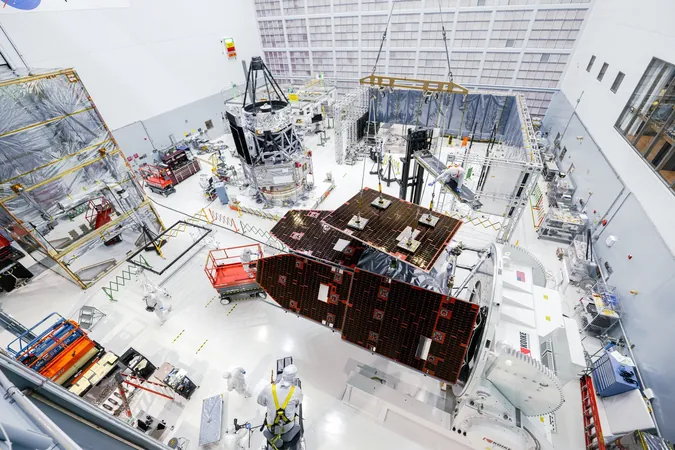
The Roman Space Telescope: A New Era of Cosmic Discovery Approaches
2025-07-11
Author: Siti
Get Ready for the Roman Space Telescope!
Set to launch in 2027, NASA's Nancy Grace Roman Space Telescope promises to revolutionize our understanding of the universe. This cutting-edge observatory will overshadow even the Hubble Space Telescope, boasting a 2.4-meter (7.9-foot) primary mirror and an astonishing field of view that surpasses Hubble's by 100 times!
Engineering Marvel Underway!
Currently in the System Assembly, Integration and Test, and Launch phase at NASA's Goddard Space Flight Center, engineers are making rapid progress. On June 14th and 16th, they accomplished a pivotal milestone by installing the Solar Array Sun Shield—a crucial power source for the mission.
This innovative shield consists of six solar panels: the two central panels remain fixed to the observatory's exterior, while the four others will unfurl and align in space, much like the Sunshield of the James Webb Space Telescope. By blocking external heat, it ensures that Roman's sophisticated instruments remain cool—critical for infrared observations of the universe’s most distant and dim celestial objects.
On the Path to Launch!
According to Jack Marshall, the Solar Array Sun Shield lead at NASA Goddard, the observatory is now approximately 90% complete. With just two major assemblies left to connect, the team is poised to conduct a series of rigorous tests. Excitingly, they are on track for an earlier launch than the previously announced date of May 2027.
Testing Phase Begins!
With the solar panels securely in place, preparations are underway for testing the core of the Roman Space Telescope. Engineers will deploy the solar panels and the observatory's aperture cover, affectionately known as the "visor." They’ll also evaluate the electronics within the core and run thermal vacuum tests to ensure it can withstand the rigors of space.
The goal is to integrate the inner and outer sections and conduct pre-launch evaluations by November, with a target launch potentially as early as Fall 2026!
Unveiling the Universe's Secrets
Named in honor of Nancy Grace Roman, NASA's first Chief of Astronomy, the agency fondly refers to her as the "mother of the Hubble Space Telescope." Once operational, the Roman Space Telescope will delve into the mysteries of exoplanets, planet-forming disks, and the farthest galaxies to unveil the true rate of the universe's expansion (the Hubble Constant).
But that's not all! Working alongside the James Webb Space Telescope, Roman will not only help map planets across our galaxy but also assist in the ongoing quest for extraterrestrial life. This ambitious mission is set to illuminate dark energy challenges and other unanswered questions in astronomy and cosmology.
A Future Full of Possibilities!
With each advance in its development, the excitement grows around what the Roman Space Telescope will reveal. As it gears up to unlock the universe's deepest secrets, the countdown to its historic launch continues!





 Brasil (PT)
Brasil (PT)
 Canada (EN)
Canada (EN)
 Chile (ES)
Chile (ES)
 Česko (CS)
Česko (CS)
 대한민국 (KO)
대한민국 (KO)
 España (ES)
España (ES)
 France (FR)
France (FR)
 Hong Kong (EN)
Hong Kong (EN)
 Italia (IT)
Italia (IT)
 日本 (JA)
日本 (JA)
 Magyarország (HU)
Magyarország (HU)
 Norge (NO)
Norge (NO)
 Polska (PL)
Polska (PL)
 Schweiz (DE)
Schweiz (DE)
 Singapore (EN)
Singapore (EN)
 Sverige (SV)
Sverige (SV)
 Suomi (FI)
Suomi (FI)
 Türkiye (TR)
Türkiye (TR)
 الإمارات العربية المتحدة (AR)
الإمارات العربية المتحدة (AR)